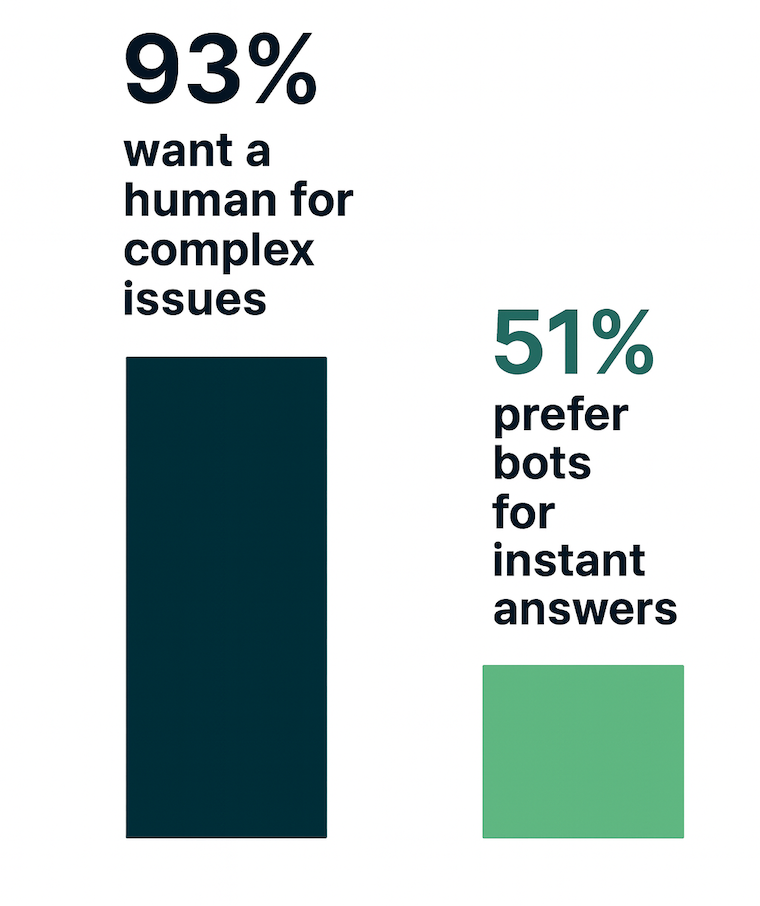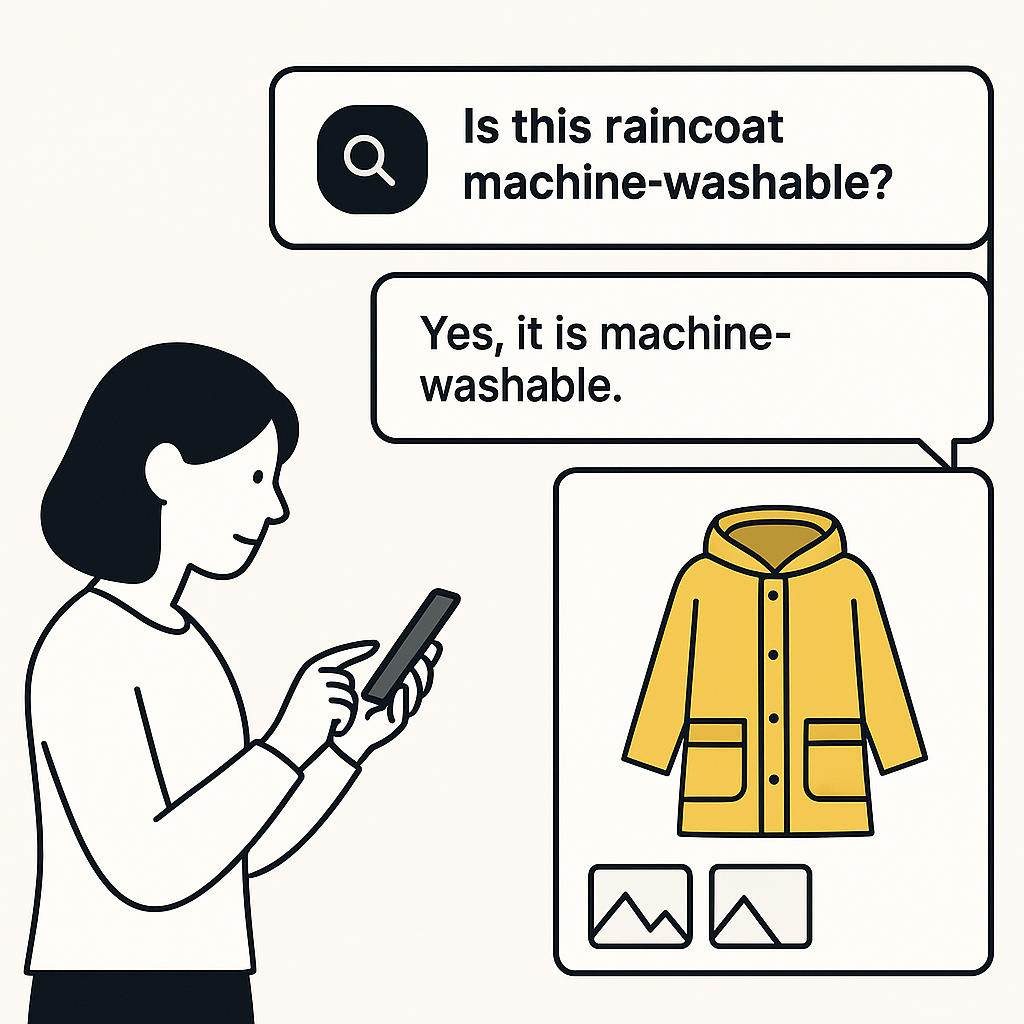TL;DR
Customers still crave human help for tricky issues, but AI excels at quick answers, data crunching, and context. The sweet spot is "AI-augmented service": let machines handle repetitive or pre-purchase questions, then hand complicated cases to people. Below are seven battle-tested ideas, plus a roadmap to roll them out safely.
1. Why We Need to Rethink "Chatbots"
Consumers still trust humans for complex problems. A May 2025 U.S. survey found 93% of shoppers prefer a live agent when an issue feels high-stakes. Only 12% prefer an AI-only route.
Yet shoppers do like AI for speed: 51% choose bots for "instant answers" if the question is simple.
Modern AI can live anywhere—inside product pages, search bars, or review feeds—not just the dusty chat bubble at the bottom-right corner.
Key Takeaway
Think in terms of micro-assistants embedded along the journey, not one monolithic chatbot.

2. Seven High-ROI AI Use Cases
| # | What it does | Why it works | Real-world cue |
|---|---|---|---|
| 1 | Product-Page Q&A Assistant | Answers sizing, material, or compatibility questions using listing data & reviews. | Amazon Rufus is live across U.S. product pages, pulling from specs + reviews. |
| 2 | Review Summaries | Boils thousands of reviews into pros, cons & themes in seconds. | Yotpo's AI summarizer boosts conversion by surfacing "need-to-know" insights. |
| 3 | Conversational FAQ Widget | Handles store policies, shipping times, and order-status checks; escalates to humans on edge cases. | Zendesk's Freddy AI auto-hands complex chats to live agents. Zendesk |
| 4 | Post-Purchase Order Tracking Bot | Lets shoppers ask "Where's my parcel?" on any channel; fetches real-time status via API. | Genesys notes 70% of WISMO ("Where is my order") tickets are automatable. Genesys |
| 5 | AI Review-Response Generator | Drafts empathetic replies that match brand tone; a human approves with one click. | Cuts response time by 40% in Yotpo case studies. |
| 6 | Proactive Upsell Assistant | Suggests bundles based on cart, browsing history, and margin targets. | Shopify Sidekick can propose cross-sell flows to merchants or directly to shoppers. eesel AI |
| 7 | Agent-Assist Copilot | Real-time suggestion engine that drafts replies, surfaces order data, and logs notes automatically. | Forrester calls this "AI guidance" a key driver of AHT (average handle time) cuts. Forrester |

3. Implementation Checklist (keep it simple)
Rolling out AI for customer support doesn’t have to be overwhelming. Here’s a step-by-step approach to make sure it works well from day one.
a) Always Keep a Human Option
Customers should never feel “trapped” with a bot.
- • Send sensitive or high-value cases straight to a human.
- • Always have a “Talk to a human” button that’s easy to find, ideally within two clicks.
b) Use Native Data Feeds, Not Scraping
Scraping your website content is clunky and can break easily. Instead, use tools than use your own data to train the AI (product feed, access to orders via the API, reviews, etc).
Pro tip: Store details like specs, images, and product variations in a structured format so the AI can give more accurate answers.
c) Start Small, Then Add Features
Don’t try to launch everything at once. Build in phases:
- Phase 0: Import FAQs and create review summaries.
- Phase 1: Add order tracking lookups.
- Phase 2: Layer in advanced personalization and automation.
Release each stage gradually and track results like customer satisfaction and resolution rate.
d) Check Pricing and Hidden Costs
Most AI tools charge based on usage, so costs can creep up. Watch for extras like:
- • Processing your knowledge base.
- • AI usage fees.
- • Time spent by humans reviewing AI answers.
Bottom line: Start small, stay human-friendly, keep your data clean, and watch your costs. The rest will fall into place.
4. The Crawl–Walk–Run Roadmap
Rolling out AI in stages helps you avoid overwhelm and see results faster. Here’s a realistic path many brands follow:
| Stage | What to launch |
|---|---|
| Crawl – Start with the Basics | Begin by setting up an FAQ bot and a review summarizer. These quick wins help customers help themselves, aiming for a self-service rate of 30% or more. |
| Walk – Add More Capability | Next, launch an order-tracking bot and give your team AI tools to assist them during chats. This can cut your average handle time by around 20%. |
| Run – Go Fully Proactive | Finally, add proactive cart advice (like recommending products before checkout) or automated upsells. Done right, this can lift your average order value by about 5%. |

5. Key Metrics to Track
Core Metrics
- • Containment rate How many customer questions are answered without needing a human.
- • Transfer-to-agent rate How often a bot hands the conversation over to a person. Too high means the bot isn’t doing its job well. Too low might mean customers aren’t getting the help they really need
- • Average handle time (AHT) How long it takes to resolve a conversation, plus how busy your team is overall.
- • Customer satisfaction (CSAT) / Net Promoter Score (NPS) Compare scores for AI-handled vs. human-handled conversations.
- • Conversion lift The increase in sales when product pages include AI-powered help.
Benchmarks
- • Top brands solve 35–50% of pre-purchase questions without a human. Amazon News
- • Review summarizers can boost conversion up to 4%. Yotpo
- • AI tools that support agents can save 15-25 seconds per conversation. Forrester
6. Final Takeaways & Next Steps
Re-imagine placement
Embed AI where shoppers have questions, not just in a generic chat bubble.
Let data flow natively
Invest early in solid integrations that use your existing data (product feed, orders, pages).
Blend, don't replace
Keep humans for empathy and exceptions; let AI handle volume and speed.
Iterate experimentally
Launch one micro-assistant at a time and AB-test its impact.
Measure ruthlessly
Customer satisfaction (CSAT) and transfer-to-agent rates will reveal whether the experience feels helpful or like a dead end.
Ready to implement AI-powered product support?
Start with Askful's AI-powered FAQ widget for your Magento or Shopify store. Turn product page visitors into confident buyers.
✓ 14-day free trial ✓ No credit card required ✓ Install in minutes